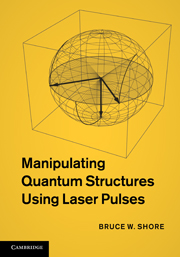Book contents
- Frontmatter
- Contents
- Preface
- Acknowledgments
- 1 Introduction
- 2 Atoms as structured particles
- 3 Radiation
- 4 The laser–atom interaction
- 5 Picturing quantum structure and changes
- 6 Incoherence: Rate equations
- 7 Coherence: The Schrödinger equation
- 8 Two-state coherent excitation
- 9 Weak pulse: Perturbation theory
- 10 The vector model
- 11 Sequential pulses
- 12 Degeneracy
- 13 Three states
- 14 Raman processes
- 15 Multilevel excitation
- 16 Averages and the statistical matrix (density matrix)
- 17 Systems with parts
- 18 Preparing superpositions
- 19 Measuring superpositions
- 20 Overall phase; interferometry and cyclic dynamics
- 21 Atoms affecting fields
- 22 Atoms in cavities
- 23 Control and optimization
- Appendix A Angular momentum
- Appendix B The multipole interaction
- Appendix C Classical radiation
- Appendix D Quantized radiation
- Appendix E Adiabatic states
- Appendix F Dark states; the Morris–Shore transformation
- Appendix G Near-periodic excitation; Floquet theory
- Appendix H Transitions; spectroscopic parameters
- References
- Index
Appendix H - Transitions; spectroscopic parameters
Published online by Cambridge University Press: 07 October 2011
- Frontmatter
- Contents
- Preface
- Acknowledgments
- 1 Introduction
- 2 Atoms as structured particles
- 3 Radiation
- 4 The laser–atom interaction
- 5 Picturing quantum structure and changes
- 6 Incoherence: Rate equations
- 7 Coherence: The Schrödinger equation
- 8 Two-state coherent excitation
- 9 Weak pulse: Perturbation theory
- 10 The vector model
- 11 Sequential pulses
- 12 Degeneracy
- 13 Three states
- 14 Raman processes
- 15 Multilevel excitation
- 16 Averages and the statistical matrix (density matrix)
- 17 Systems with parts
- 18 Preparing superpositions
- 19 Measuring superpositions
- 20 Overall phase; interferometry and cyclic dynamics
- 21 Atoms affecting fields
- 22 Atoms in cavities
- 23 Control and optimization
- Appendix A Angular momentum
- Appendix B The multipole interaction
- Appendix C Classical radiation
- Appendix D Quantized radiation
- Appendix E Adiabatic states
- Appendix F Dark states; the Morris–Shore transformation
- Appendix G Near-periodic excitation; Floquet theory
- Appendix H Transitions; spectroscopic parameters
- References
- Index
Summary
Between every pair of quantum states for which a nonzero electric or magnetic multipole moment exists there can take place a radiative transition. When the quantum states are both discrete, as they are for pairs of bound states, the radiation is discrete – a spectral line. The frequency of that spectral line is set by the difference of the two energies, and can occur in any region of the electromagnetic spectrum. If there is available a source of coherent radiation at that frequency, then coherent quantum-state manipulation is possible.
For many years spectroscopists routinely assembled collections of wavelengths and line strengths (or transition probabilities) for various elements and molecules. The National Bureau of Standards (NBS), now the National Institute for Standards and Technology (NIST), collected, organized, and published much of this data. Their website, www.nist.gov/pml/data/handbook/index.cfm, provides ready access to this information for all the elements and many molecules. Much of this data has appeared in the Journal of Physical and Chemical Reference Data, published by the American Institute of Physics (AIP). Diagrams showing the relative positions of energies and the connecting transitions, often called Grotrian diagrams [Bas75; Moo68; Lan99], are helpful for presenting the excitation linkages.
Spectroscopic parameters
From traditional spectroscopic studies come several parameters with which to describe the resonant interaction between light and an atom – one that exists, ideally, in free space and which therefore has degenerate energy levels.
- Type
- Chapter
- Information
- Manipulating Quantum Structures Using Laser Pulses , pp. 537 - 541Publisher: Cambridge University PressPrint publication year: 2011

